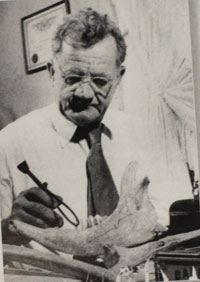
George Adams was credited with discovering the first dinosaur tracks which he discovered early in 1909 when he was exploring the Wheeler Branch tributary of the Paluxy River.
Also, some time around 1909, Ernest Adams discovered a set of footprints that he referred to as “giant man tracks”. According to Mr. Adams there was a clear set of at least 9 of these man tracks in a location known as the 4th river crossing near the waterfall several miles up the Paluxy river from Glen Rose.
At least 15 local people testified to seeing the same set of tracks in that area which became known as the 4th crossing tracks. Adams showed this set of man tracks to a young friend by the name of Charlie Moss while on one of their numerous swimming excursions on the Paluxy River. Mr. Moss, later, said this about the tracks: “They were so plain that you could see where he was walkin’ and then he got up on the balls of his feet and commenced to run.”
In 1918 another flood occurred, and the 4th crossing “giant man tracks” were swept downriver never to be seen again.

Some question whether Earnest Adams incorrectly identified these “man tracks.” Earnest Adams graduated from Baylor in 1910 with a degree in Latin and Greek. He was a Rhodes Scholar and completed a law degree at Oxford/Worchester several years later. He was proficient in eight languages and several Indian dialects. While at Worchester College, Ernest also studied in the fields of archeology and anthropology which were his passion.
Ernest “Bull” Adams was an extremely intelligent and scholarly man, and it was his belief that the earliest evidence of man was at Glen Rose.” So you decide. Was Ernest Adams capable of determining if what he saw was truly the track of a human? I think so.
Ernest Adams spent much of his later life exploring and digging in and around the Paluxy River. This man was raised in a time when evolution was not so dogmatically preached in the science classrooms and therefore, he did not have a biased presupposition regarding what he found and saw.
For more information about Ernest Tolbert “Bull” Adams, the book “This Man Called Bull” is a good resource.
It is important to note that during the depression years of the 1930’s, several of the Glen Rose residents cut dinosaur and human tracks from the bed of the river and sold them to people. Many real tracks were cut out, but it is know that in the 1930’s, several fake tracks were carved as well. The depression times were tough and people would do just about anything they could to earn enough to get by.

George Adams was known to have carved several dinosaur tracks and at least three human prints. George Adams family kept one of the carved human tracks and the image to the left is a replica of this carved print. This remains on display at the Creation Evidence Museum in Glen Rose, Texas as an example of a carved track.
“Adams was evidently handicapped by his limited carving skill; of the several loose “man tracks” which still exist and are generally attributed to him, all show serious anatomic errors, including misplaced ball and arch, and excessively long, misshapen toes.”(Quote from: TalkOrigins.org)
Ernest T. Adams: Born 1888-Died 1961
George B. Adams: Born 1891-Died 1959
References:
Interviews with Carl Baugh, R.C. McFall, and Robert Summers.
Information about George Adams First Discovered Dinosaur Tracks
“This Man Called Bull” by Jeffery Pruitt

Heard about him all my childhood. He was an admired & respected friend of our family. Thank you for information.
The picture of the Adams boys is backward. It is Ernest, George and then Yancy.
Excellent. I have read Dr Pruitt’s book about Bull Adams
I lived in Glen Rose as a child from about 1948 to 1953. Bull was already a legend. I never met him and seldom caught glimpses of him walking down the road in front of our home. My father was Roy M. Clayton who was pastor of First Baptist, Glen Rose for 5 years. Bull and my father became good friends. They would sit in Glen Rose Cafe and talk religion and evolution and i guess anything else. Later Bull accepted Christ as his Savior and asked my father to baptize him. Later Bull had designated my father to officiate at his funeral which he did. My friend Robert Summers who lived in Glen Rose became a well-known western artist lived across Tornado Drive from Bull. They had a great relationship. Glen Rose was an amazing place .